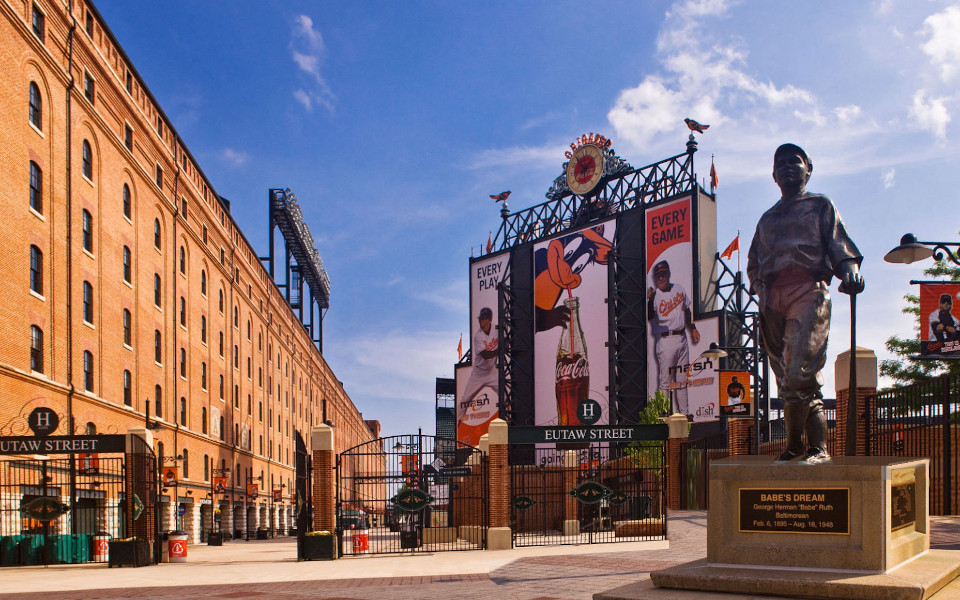
Last visited: June 15, 2024
George Will once said, “The three most important things that have happened in baseball since the Second World War were Jackie Robinson taking the field in Brooklyn in 1947, free agency arriving in 1975, and Oriole Park at Camden Yards opening in 1992.”
Camden Yards changed ballparks forever. It’s why we have so many great places to watch a game today, and arguably one of the key reasons why baseball annual revenue exploded by a factor of 10 in the years since it was first built.
Camden Yards ushered in the so-called retro design: a return to old aesthetics. It fostered the school of thought that a ballpark should be built only for baseball, that it should fit into the context of its urban environment, and that it should telegraph the city it’s in. It saw the return of cantilevered decks and an open view of the city skyline. It showed how modern amenities could co-exist with timeless ballpark principals. It incorporated old city landmarks into the park design rather than bulldozing them: the rightfield warehouse helped define the park and was met with huge fanfare. Critics and fans alike were agog with this gorgeous new facility that harkened back to the glory parks of yesterday. The new home of the Baltimore Orioles became an instant classic.
To fully appreciate how much of a game changer it was, compare it to the last 6 ballparks to open before it:
- a pre-renovation Comiskey Park II (with its money-grubbing motives evident in the uninspired design)
- SkyDome (the “stadium of the future” that was outdated within 5 years)
- Joe Robbie (a football stadium reconfigured for baseball)
- Metrodome (a drab multi-purpose stadium built for $68 Million or roughly Shohei Otani’s average annual salary)
- Olympic Stadium (an expensive multipurpose white elephant deemed one of the worst MLB stadiums ever),
- Kingdome (a dull multi-purpose stadium with upper deck seats some 617 feet from home plate).
Think about all the great ballparks that have opened since. Yeah, it was big effing deal.
I saw the 9th regular season game ever played in the stadium in 1992 (you were still allowed to smoke in your seat) and was blown away. It had all the good stuff we liked about the older parks, but all of the new stuff as well. Cut to nearly three decades later, and the park still holds up.
There was revolutionary brilliance in some of things that have become commonplace in newer parks:
- Ramps heading to the upper deck were on the inside of the façade, as opposed to sticking out like a sore thumb on the outside like at most parks
- The field was sunk below street level, allowing for a more majestic entrance. This lowered the overall structure, making the park less intrusive in the neighborhood.
- They recognized and honored previous Baltimore teams and the heritage of baseball without being cartoonish about it; from the old-timey clock in center, to the foul pole brought over from old Memorial stadium, to the statues and Hall of Fame plaques of former Oriole greats, to the vintage look of the ads and signage, everything respected the past
- They were the first to have two-tier bullpens to allow more fans to see the pitchers warm up, not just the ones who could see behind the outfield fence
- It brought back the classic (albeit now over-copied) “baseball color scheme” of a red brick exterior, black wrought iron and dark green seats
- It ushered in the idea of offering local fare to the fans inside the ballpark
The stadium was a critical piece in revitalizing the Baltimore Inner Harbor, making the area an attractive tourist destination today. It was also critical in revitalizing the interest in baseball, spawning a stadium boom that helped the sport recover from the disastrous 1994 strike.
Admittedly importance does not equate to perfection. As is wont to happen, some of its successors have made better physical structures. But it’s still one of the best in the business. It has that “Wow factor” in spades. And given the massive importance of this place, it gets any benefit of the doubt.

STADIUM 38.5/50
Exterior aesthetics 10/10; Interior & Concourse Aesthetics 6/10; Sightlines 3/5; Seating 3/5; Traffic flow 5/5; Scoreboard 5/10; Amenities & entertainment 3/5; Bars & Restaurants 3/5; Celebrating history 4/5; Grand entrance 5/5; Sense of place 21/25; WOW Factor 9/10. Total 77 points divided by 2 for 38.5
This was truly brilliant design that will likely stand the test of time. Much like Wrigley transcends the Cubs playing in it, Oriole Park at Camden Yards does the same thing in Baltimore.
THE GOOD:
- Camden Yards brought back the idea of opening a park up to the surrounding neighborhood. Stadium designs that preceded it were virtually entirely enclosed, either to accommodate a second sport, or as a way to ensure all views were paid views. The last park to have an outfield open to its surrounding was Royals Stadium, and it opened onto an interstate. Before that, you’d have to go to the parks that opened before the cookie cutter circular bowls like Crosley Field, Connie Mack Stadium or Forbes Field. Before the modern Hilton hotel was built, the park perfectly framed the iconic Bromo Seltzer tower, telegraphing its city.
- The 8-story 1,116-foot long B&O warehouse is maybe the most iconic feature of any ballpark outside the Wrigley ivy or the Green Monster. It brings untold character to the place and creates a nifty urban vibe. Inside the warehouse are some team stores and a brewpub open to all fans before and during the game.
- Eutaw street runs inside the ballpark. It’s open to the public on non-game days. On game days, it helps with throughput before and after the game. The Red Sox used this inspiration to help ease crowding inside Fenway.
- The outfield dimensions of the park were made to fit its context. They weren’t quirky for the sake of quirky, but a product of the space. But after years of antiseptically standardized fences, it was nice to have some different dimensions again.
- The area in front of the warehouse was made into a standing room area, one of the first purposefully designed SRO spaces made in a stadium in years. It created a social space for gathering, a concept ahead of its time.
- The green ivy colored batter’s eye, which sits very close to where Babe Ruth’s father’s pub used to sit, is one of the nicer batter’s eyes and became a model for others
- The seats are some of the widest in baseball, great for horizontally-challenged fans like myself
- Small touches like logos on the sides of the seats at the end of every row just add to the visual splendor
- The Legends Park statue area and the Orioles Hall of Fame wall do nice jobs respecting previous greats
- The structure feels way more intimate than its 46,000-seat capacity
THE BAD:
- The sightlines aren’t great, especially down the lines. Seats aren’t angled toward the infield, forcing you to do a full game neck turn.
- The wide concourses are closed from the playing field. When grabbing another crab cake, you can’t see the game.
- There’s a lack of some of the premium seating options found at other parks. This makes it more egalitarian for the fan but puts the club at a revenue disadvantage which seemed to hurt the product on the field for years.
- The videoboard, by modern standards, is small even after being replaced once already. It’s about a quarter the size of the Mets’ behemoth and is one of, if not THE smallest, in the MLB.
- The cantilever of the second deck is so significant, some of the back row Terrace seats are fairly obstructed
Many of those sore points were corrected by subsequent stadiums. Even with those flaws (some of them fairly egregious) it’s still a wonderfully conceived ballpark that advanced stadium building so much. Of all 30 parks in the bigs, it’s the one that I feel most confident will still be standing in 50 years.
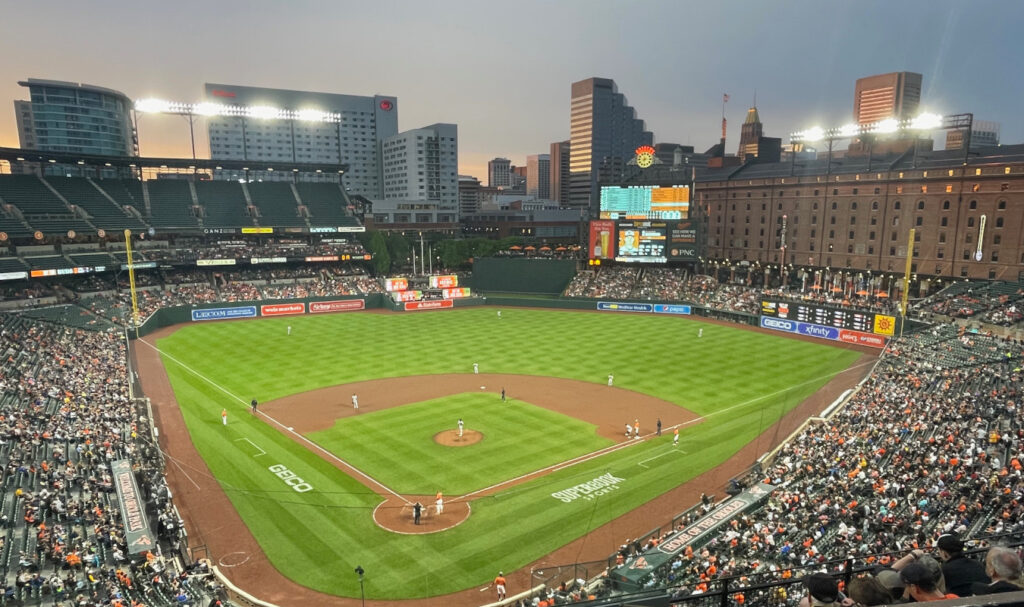
FOOD 8/10
The Orioles ushered in the concept of local delicacies when they opened in 1992. Some of those originals still satisfy fans today such as handmade soft pretzels shaped like the O logo and the delicious smoked meaty goodness coming from Boog’s BBQ (the Pit Beef sandwich is still my go-to).
Other local concessions include encased meats from Stuggy’s (try the Mac n cheese dog), tacos from Vida Taco Bar, good pizza from either Squire’s or Oro’s, a smash burger from Fuzzie’s, and pupusas from Maria’s. Old Bay seasoned fries are a hit. You can even get a crab cake sandwich, crab dip boule, and a host of other goodies including Old Bay shrimp camarones from the Superbook Sports Bar in the warehouse.
Standard ballpark fare is also pretty good. There’s a $4.10 value menu for hot dogs, small soft drinks and kiddie-sized snacks. Big Mozz sells their cheese sticks. And Fuku offers for their great chicken sandwich.
But my personal fave is the crab cake roll from Jimmy’s Famous Seafood. It’s a Top 5 concession in all of MLB. Two lumps of crab on a buttered roll. Expect a long line, but it’s bonkers good!
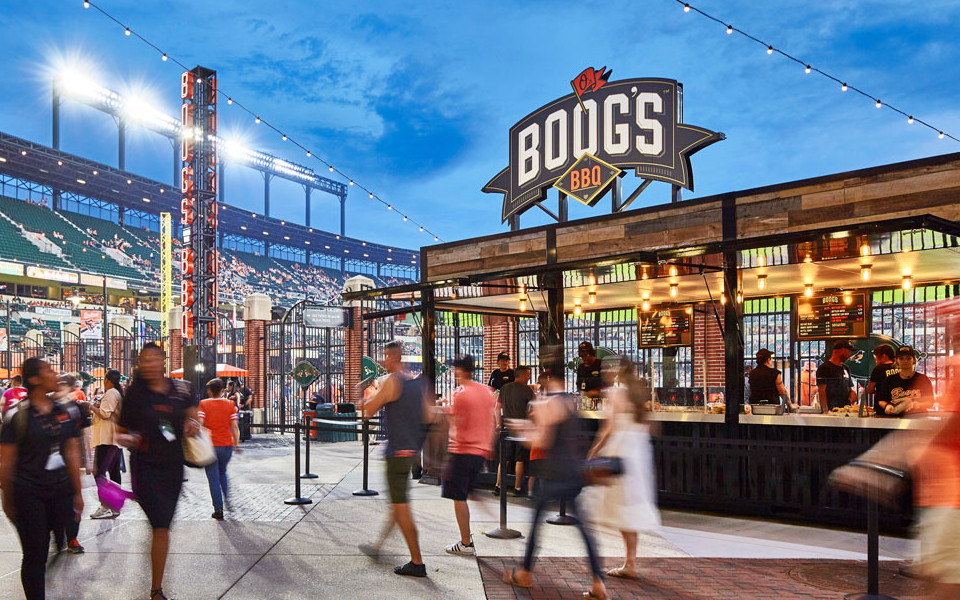
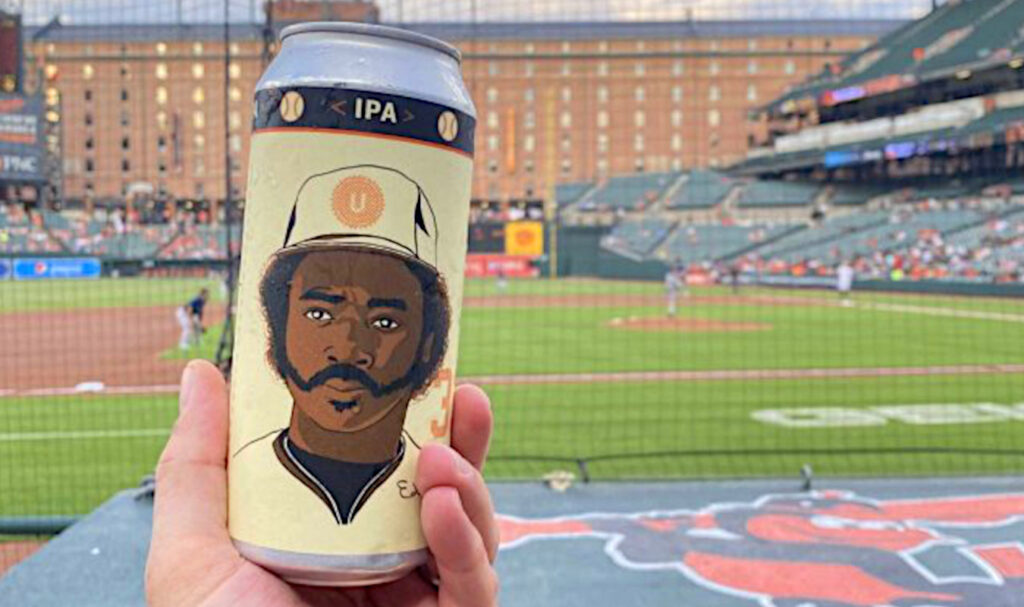
BEER 7/10
Natty Boh is back, and the world feels right. In fairness, there are better options, but much like Old Style at Wrigley, it feels mandatory to have one at Camden Yards.
Union Brewing makes two great beer available at the park: Duckpin pale ale and Steady Eddie IPA. You can also get stuff from Heavy Seas (including the Loose Cannon IPA), Checkerspot Brewing, Key Brewing Co. (including their Dundalk Calling IPA), RAR Brewing Co, Monument City Brewing Co and Baltimore Beer Works. The roving vendors sometimes even sell Frederick, MD based Flying Dog.
The middle of the pack score is due to the relative lack of draught taps (almost everything is canned, and I’m a poncy from-a-glass guy), and the difficulty in finding some of the more interesting options.
NEIGHBORHOOD 8/10
This part of town used to be a blighted area, but well-planned urban development really did help rejuvenate it. You still need to be careful in surrounding areas, but the ballpark and Inner Harbor areas are nice.
The most popular pre-game spots, Pickles Pub and Sliders Bar & Grille, are located right across the street. Babe Ruth’s birthplace is just two blocks away. There are also some good places in the Inner Harbor and along Pratt Street. Federal Hill southeast of the park, and Fell’s Point east of the Harbor are also quite hopping if you’re willing to go further afoot.
COST 4/5
Since Washington came back into the league, the Baltimore Orioles have had to price competitively in order to attract fans, especially during hard times. But they’re creeping up a little as they’ve improved and crowds have returned. Concessions and merchandise are standard, and parking is relatively affordable.
ACCESSIBILITY 5/5
It’s easily reached by highway. There’s lots of parking in the area. And there are Light Rail and MARC train stops right at the ballpark. It’s among the most accessible parks in the Big Leagues.
WEATHER 2/5
It’s a little warmer in April than the Midwest, but still quite wet. Early summer nights can be lovely though.
VIBE 18/25
The O’s had been languishing most years for the past decade and the former owner wasn’t very well-liked. This resulted in reduced crowd sizes, making for a less jovial atmosphere. When the Yankees or Red Sox come to town, the place filled up, but was a split crowd. But the O’s recent resurgence has brought fans back, fueled by new ownership and a young, likable team. It’s fun again in Baltimore!
The game day staff is quite nice with plenty of retirees. Some of the vendors are real characters as well. On game day, it seems as if the entire stadium area turns into a “baseball place” with many street vendors hawking wares and lots of jerseys on the streets.
The great National Anthem tradition of yelling out the second “O” in unison continues to this day. The odd selection of “Thank God I’m a Country Boy” after the 7th inning stretch also continues (weird because Camden Yards feels like one of the most urban parks, but it’s a tradition that started in old Memorial Stadium in 1983, so you gotta respect the staying power).
This place just exudes baseball. It’s a rare stadium that never needed a great crowd to throw off a good vibe. Thanks to its sheer beauty and attention to detail, you want to be here. The place creates its own vibe, which is unique for any stadium built in the last 100 years. And with all the small bars inside the stadium itself, it’s not a bad place to come early, watch some BP and just soak it all in.
GALLERY
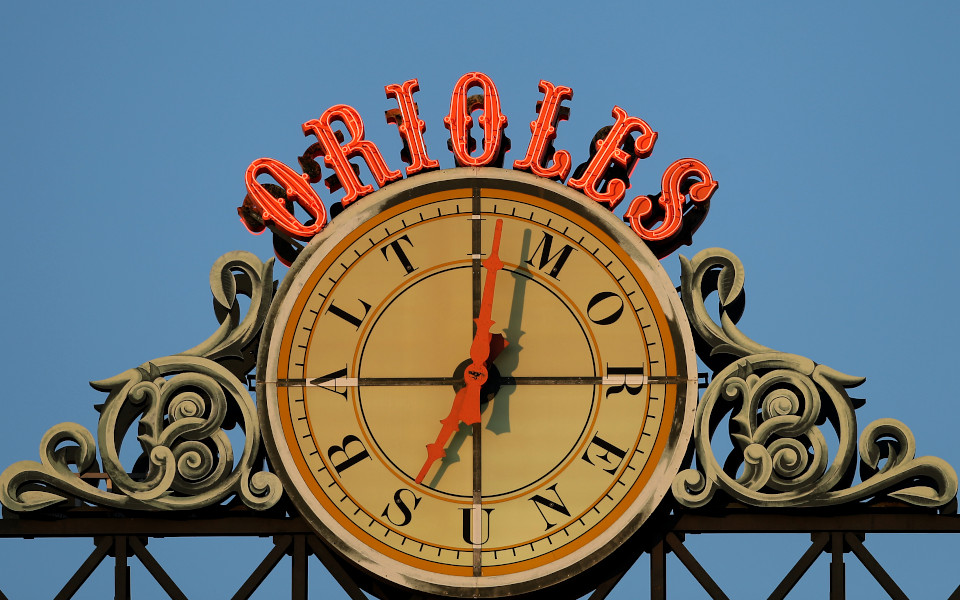
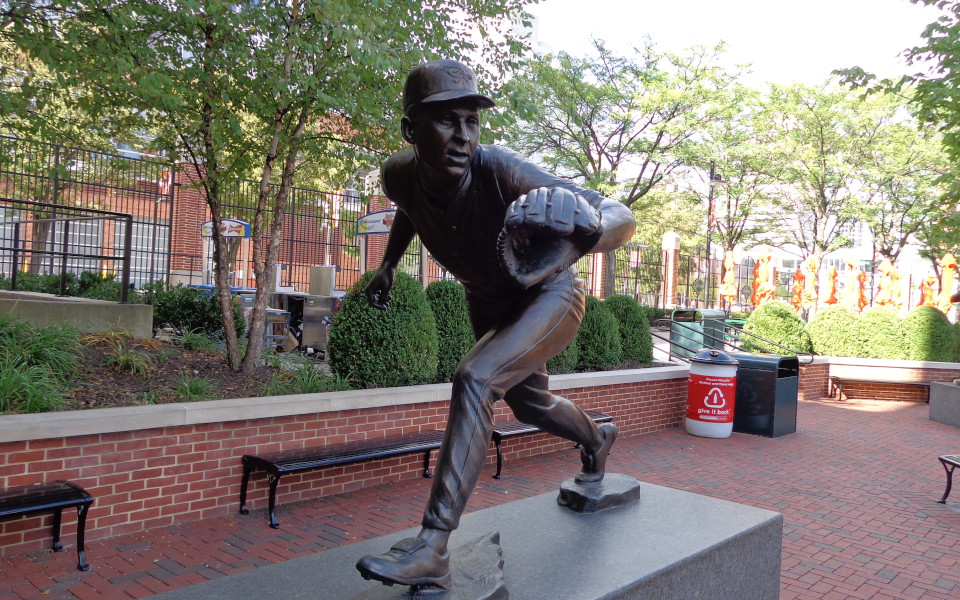
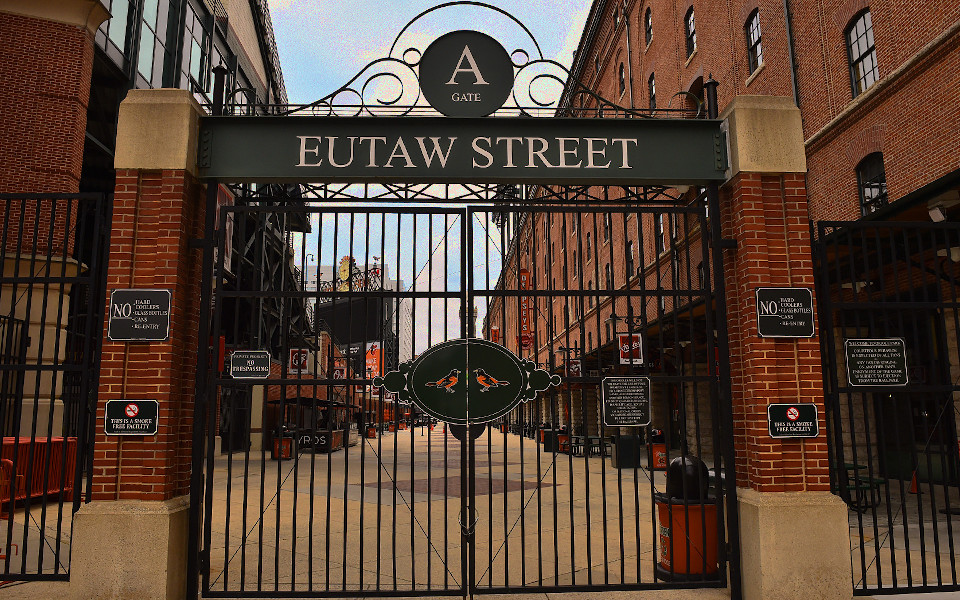
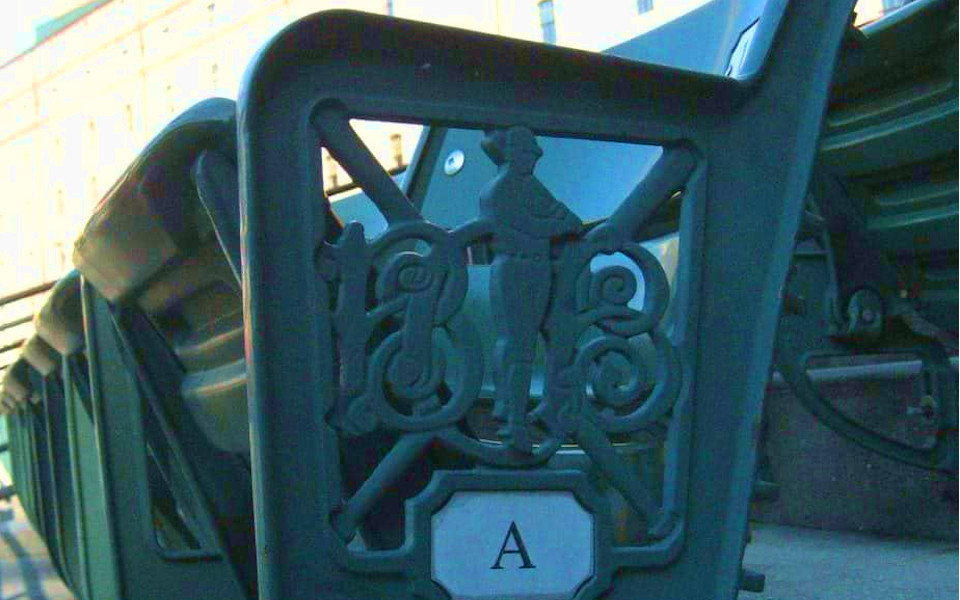
OTHER FUN THINGS TO DO
Three fun Charm City eateries:
- Chap’s Pit Beef (Pulaski Industrial Area in NE Baltimore. Pit beef is a Baltimore delicacy, and Chap’s is arguably the best at it.)
- Faidley Seafood (Lexington Market. Arguably Baltimore’s best crab cakes.)
- Wet City/The Brewer’s Art (Mt Vernon. Alight at the Cultural Center stop, 5 Light Rail stops north of the ballpark to find these places that combine good food and craft beer. Wet City is a small place with a rotating tap list of local gems and good nibbles. Brewer’s Art is an upscale gastro brewpub specializing in their own Belgian-style beers.)
Three places to imbibe before the game:
- Pickle’s Pub/Sliders (Ballpark. “Bro” atmosphere in popular classic sports pubs right by the park.)
- Pratt Street Alehouse (Inner Harbor. Taproom housing Oliver’s Breweries, with British-style ales and creative pub fare.)
- Checkerspot Brewing Company (Stadium/Entertainment Area. Just south of the football stadium is a fine female-owned craft brewery. If you find legal parking around there, leave your car and walk the 20 minutes to the ballpark.)
One bar in the area worth hitting:
Max’s Taphouse (Fells Point. One of my Top 10 bars in the country. 150 taps including some hard-to-find gems. No-nonsense bartenders. Gets busy at night, but pretty chill for day drinking. Decent grub as well.)
Three craft breweries in the area worthy of your time:
- Union Craft Brewery (Medfield. Relaxed taproom with food trucks. Come for the Duckpin, then try some of the other stuff. 6 miles north of the stadium.)
- Heavy Seas (Halethorpe. Run by the brewer who founded Maryland’s first brewpub, specializing in heavy gravity beers. Also just two miles from the amazing Guinness Open Gate brewery)
- Jailbreak (Laurel). A haul from downtown B’more (30 miles), but makes very good stuff and opens at 11am; a great stop if coming from or heading to DC.
Three fun tourist attractions in the area:
- Fort McHenry (Take a water taxi over to see the place that inspired the National Anthem)
- Babe Ruth Birthplace Museum (If your touring ballparks, you need to make the quick stop here)
- National Aquarium/Inner Harbor (One of the better aquariums in the country. The rejuvenated harbor is also fun to stroll/scooter)
SUMMARY
Any baseball fan should thank Larry Lucchino for what he did to the stadium experience. Camden Yards’ timeless charm still holds up today which is incredible when you think that 2 stadiums built after it are already retired. It’s among the most beautiful of all the stadiums, providing both the immediate “Wow” for first timers, and enough charm to reward the repeat guests. It was an “instant classic” when built, and with close to $600 million in upgrades coming, it should provide great memories for O’s fans for decades to come.
